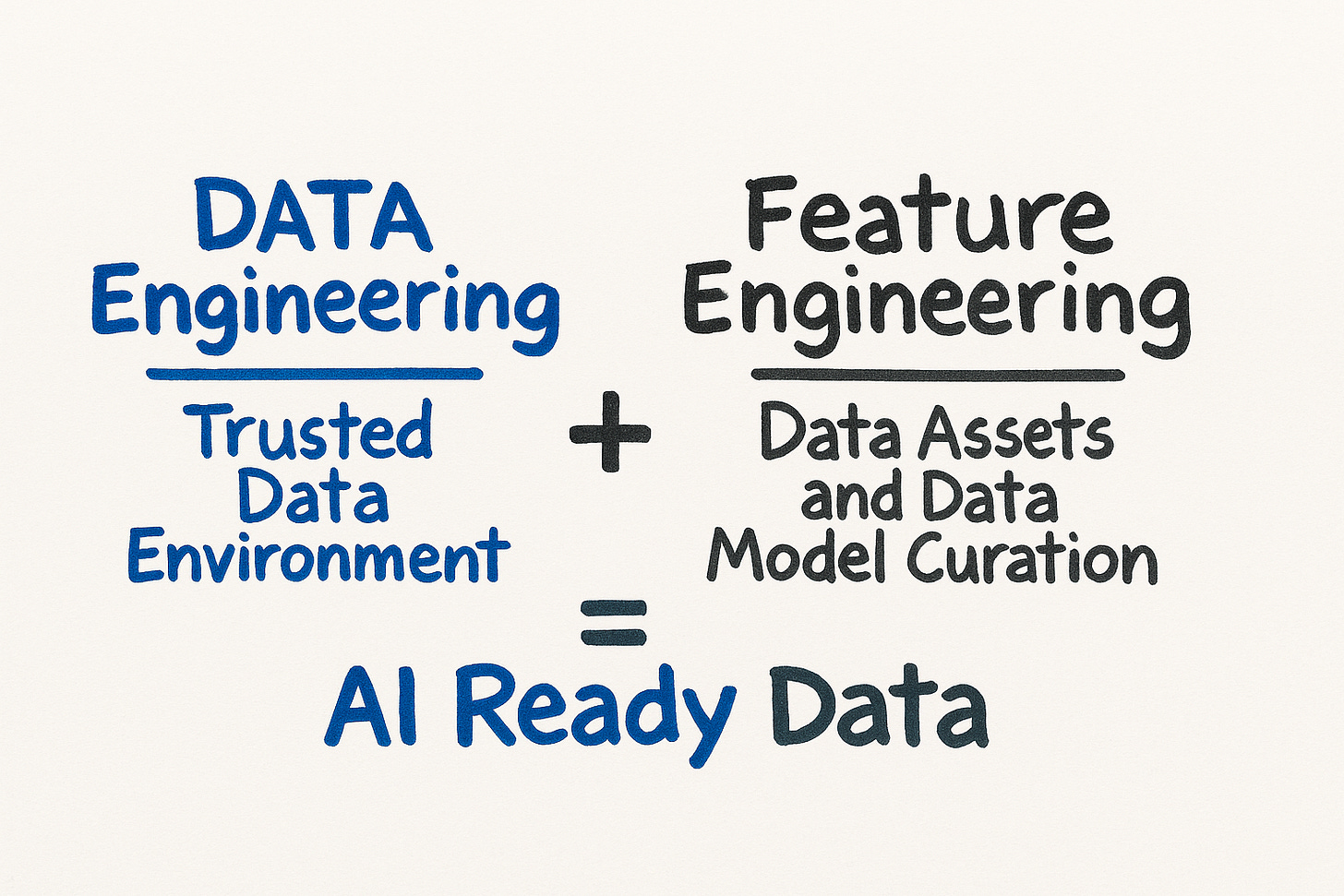Getting to true, AI Ready Data
It isn't just about your data infrastructure—It's about your culture towards collaboration and analytics
📌 THE POINT IS: AI Ready Data created by the combination of data teams, data scientists, and line-of-business analytics teams. It isn’t merely a budgeting and prioritization conversation (although those are real challenges)—it’s a cultural revolution. Establishing a Trusted Data Environment and reusable Data Assets is vital, but success hinges on building a cohesive, collaborative culture that integrates tech, analytics, and business teams into a unified force.
Go deeper by downloading and reading my full whitepaper on how to build AI-Ready Data systems which include the trusted data environment and model-ready data preparation!
Most businesses jumping into AI overlook one crucial factor: the quality and accessibility of their data. Investing heavily in advanced AI algorithms and platforms without first establishing a solid data foundation is a bit like building a mansion on sand—eventually, it crumbles.
My recent whitepaper, AI Ready Data: The Foundation of Enterprise AI Success (link above), captures this perfectly. It argues persuasively that "AI-ready data" isn’t just a technical term but a strategic imperative that rests on two foundational elements:
Trusted Data Environment: An infrastructure delivering accurate, timely, and discoverable data directly linked to source systems.
Reusable Data Assets: Curated datasets and pre-engineered features representing trusted business logic, ready for AI model deployment and reuse.
Critically, both of these pillars are enabled and enhanced by active metadata through a robust data catalog, creating transparency and trust in every data-driven decision.
Yet, there’s a deeper, often overlooked layer—culture. Without a cohesive culture that promotes collaboration and trust among data, analytics, and technology teams, even the most sophisticated data infrastructure will fail to deliver its potential value.
From my experience formerly leading Data Culture at GE, I can attest that the hardest challenges—and greatest opportunities—lay in breaking down silos and aligning different teams toward a shared mission. At GE, we didn't simply build data infrastructure; we constructed a federated structure linking centralized data and analytics teams closely with our business units. Our secret weapon: a strong, cross-business culture with a core of expertise, platform scaling, and integration of the data and analytics teams which helped us focus on product management and wing-to-wing problem solving.
I also built a data practitioners Guild which served as a cross-functional group where experts from line-of-business, product, data, analytics, and technology came together. At Bank of America, I created a data council which served a similar purpose. Together we collaborated holistically, jointly tackling complex problems while making sure we shared learnings and training opportunities. Everyone brought unique expertise to the table, but what truly mattered was our unified perspective: understanding the full scope of the business challenge and crafting solutions as a cohesive unit.
Today, more than ever, enterprises need exactly this kind of integrated, interdependent thinking. AI readiness isn't just about technology or budgets—it's fundamentally about people. It’s about reshaping how your teams collaborate. If data scientists, analytics professionals, tech teams, and business leaders remain isolated in their corners, leveraging data for meaningful AI will remain an uphill battle. Similarly if your corporate culture is to remain within your business unit and not look to see if the enterprise has solutions and collaboration opportunities already available, then you risk cutting your innovation and speed to market off at the knees. It's imperative for people to go deep in their business area to solve problems while not sacrificing critical accelerators such as simply expanding your connections to other parts of the business.
As Gartner reports, 91% of organizations are failing to achieve data maturity due to fragmentation and poor data governance. McKinsey emphasizes that without data readiness, businesses can't fully leverage AI innovations, especially emerging generative and agentic technologies.
Yet, companies that have succeeded—Nestlé’s centralized data lake, Uber’s feature store, and Deloitte’s manufacturing case studies—all reveal a common thread: collaboration. Each successful organization broke down walls between business functions and their respective data teams, aligning efforts around trusted, governed data assets.
As I experienced at GE, the path forward requires transforming data governance from a bureaucratic function into a cultural asset. It means embracing a mindset where analytics and tech aren’t separate realms but integral partners in driving business outcomes.
The cultural shift needed is clear:
Single Source of Truth: Everyone relies on the same governed data assets—no shadow data, no unofficial spreadsheets.
Collaborative Stewardship: Cross-functional data stewards ensure accuracy, consistency, and accessibility.
Data as Product: Teams proactively manage data like a strategic product, emphasizing reuse, quality, and continuous improvement.
Ultimately, the goal is simple but profound: creating a unified data culture where data-driven decision-making becomes seamless, transparent, and trusted across your enterprise. Data Product ownership and management secures the long-lasting success of products including advertising that they exist, quick reuse such as in the Uber example in the Whitepaper, continuously expanding on them with a product roadmap, and ensuring funding pipelines remain strong. It’s about expanding successful practices from your other business operations to your data ecosystem. This powers your AI and any other analytics-based strategies.
When we built guilds at GE, we didn't just create another meeting—we fostered a shared identity, ownership, and accountability. In the absence of an organization model that already brings data and analytics professionals together, data scientists included, a guild or data council can be crucial.
What it takes to be AI-ready today: trusted data, data assets such as pre-engineered features and curated data models, but also a culture of collaboration to maximize both of them. It's not tech vs. analytics or enterprise vs. business. It’s all of us together, as one team, driving forward a common mission.
We are interdependent now more than ever. Let’s ensure our culture reflects this reality—our AI success depends on it.
Matt Brooks is a seasoned thought leader and practitioner in data and analytics; culture; product development; and transformation.




